A longitudinal study of self-selection, learning-by-exporting and core-competence: The case of smalland medium-sized enterprises in Vietnam
Based on longitudinal data from biennial surveys of small- and medium- sized enterprises (SMEs) in
Vietnam conducted from 2007 to 2013, we find supports to the self-selection and learning-by-exporting
hypotheses. We find that the SMEs having higher sunk costs and capital size are more likely to become
exporters. Applying the propensity score matching method in combination with the Difference-inDifference estimation, the study finds that export has raised SMEs’ productivity measured by either
TFP or labor productivity, sales revenue, and value added of the SMEs. Furthermore, the gains from
learning-by-exporting and specializing in core-competence products were stronger in the early years
of entry into the export markets. These findings suggest policies to promote export of SMEs in an
appropriate timing
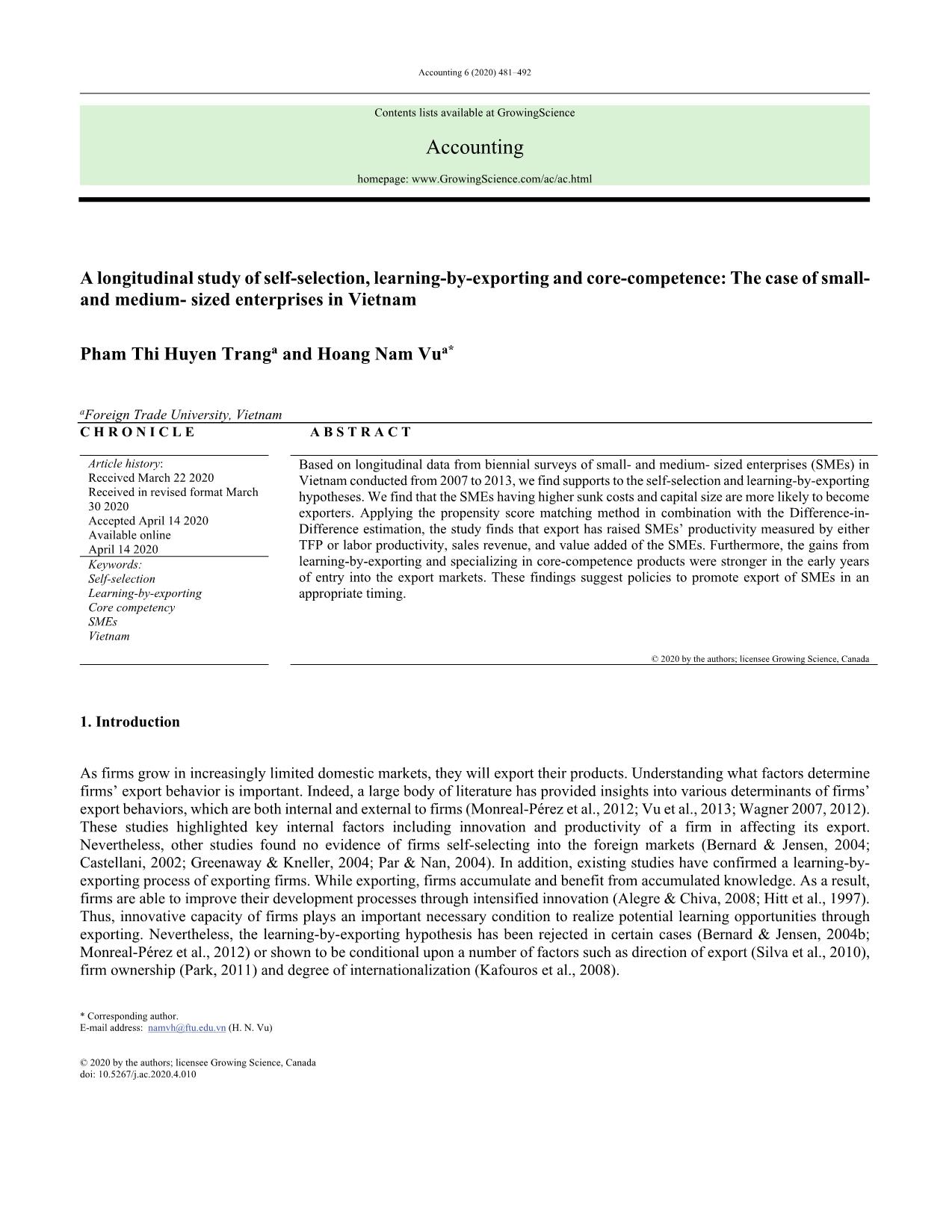
Trang 1
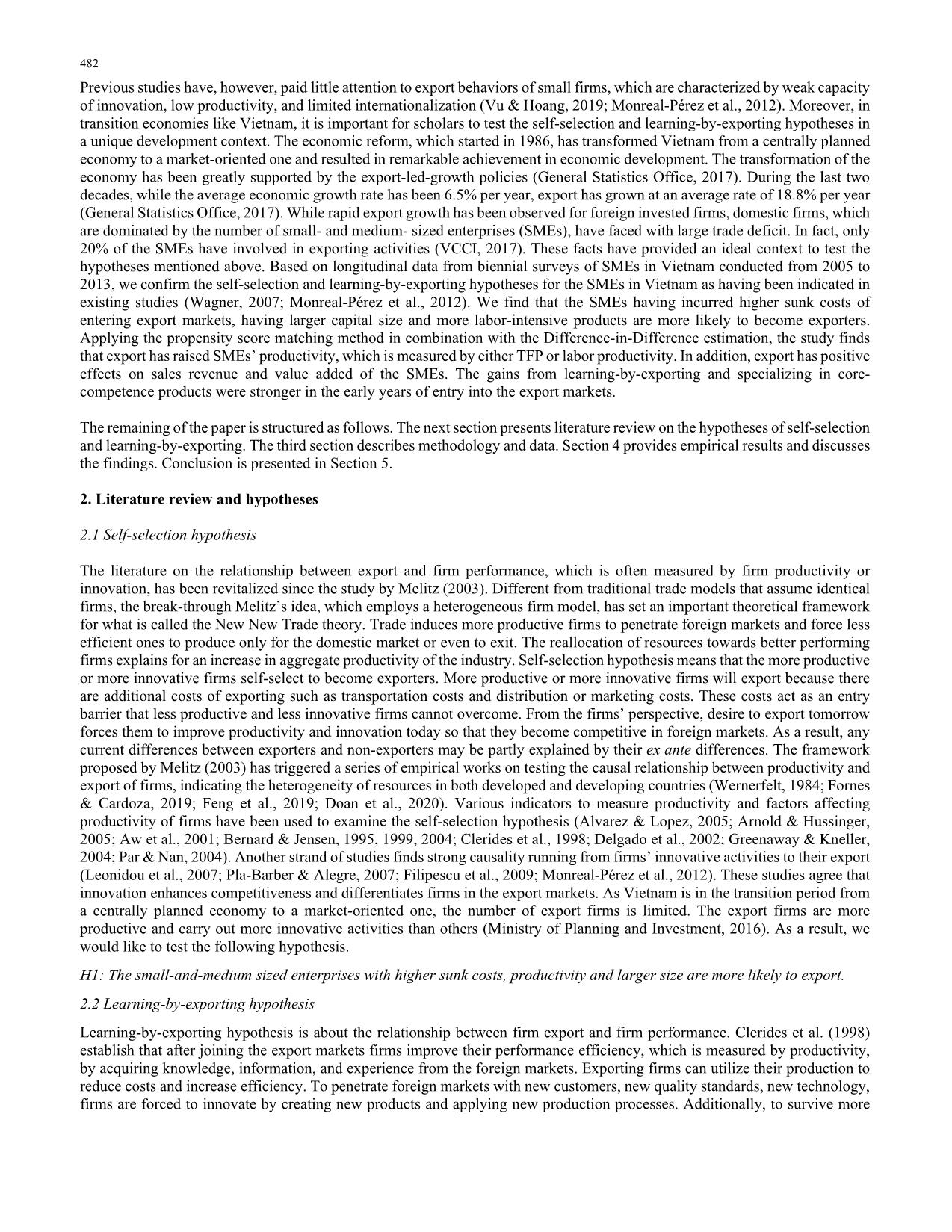
Trang 2
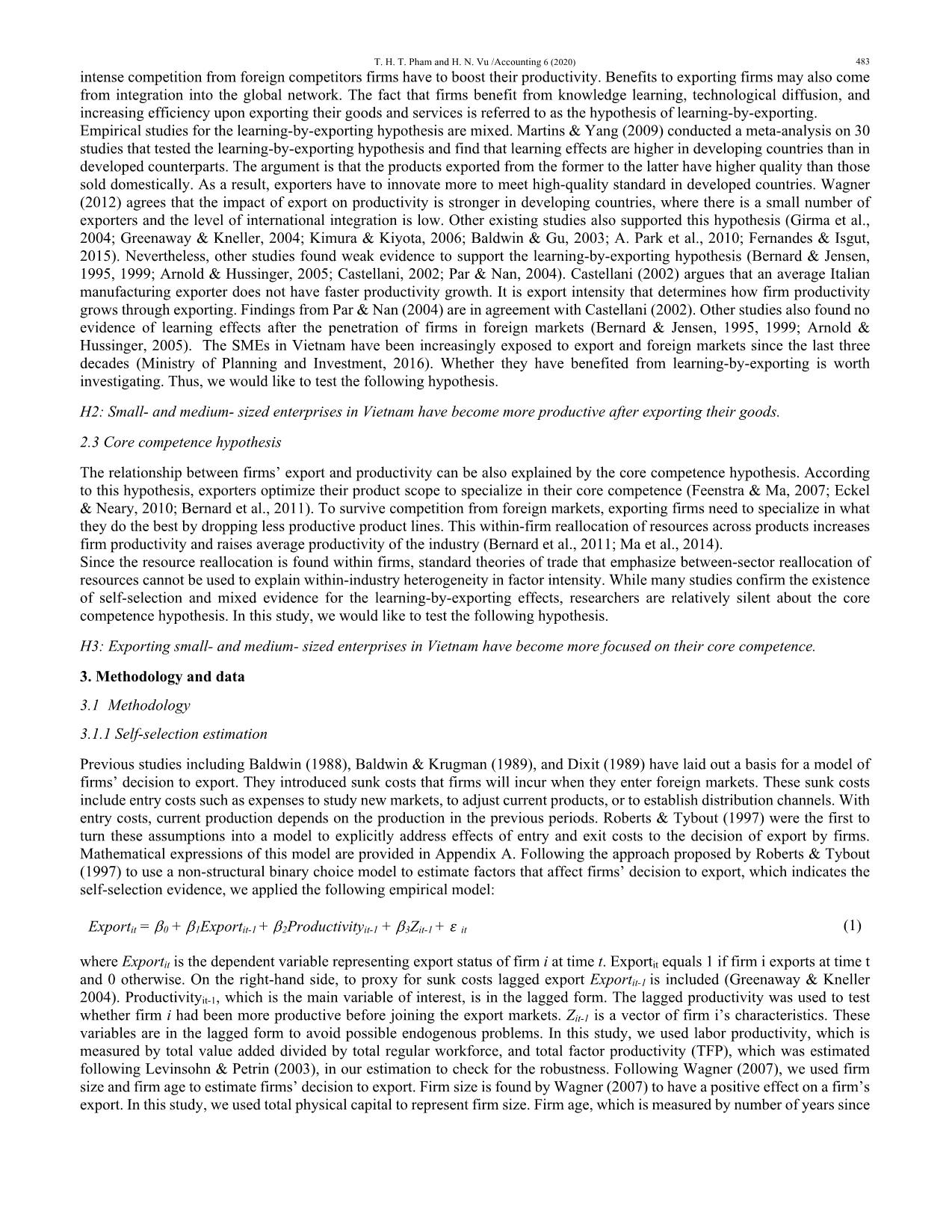
Trang 3
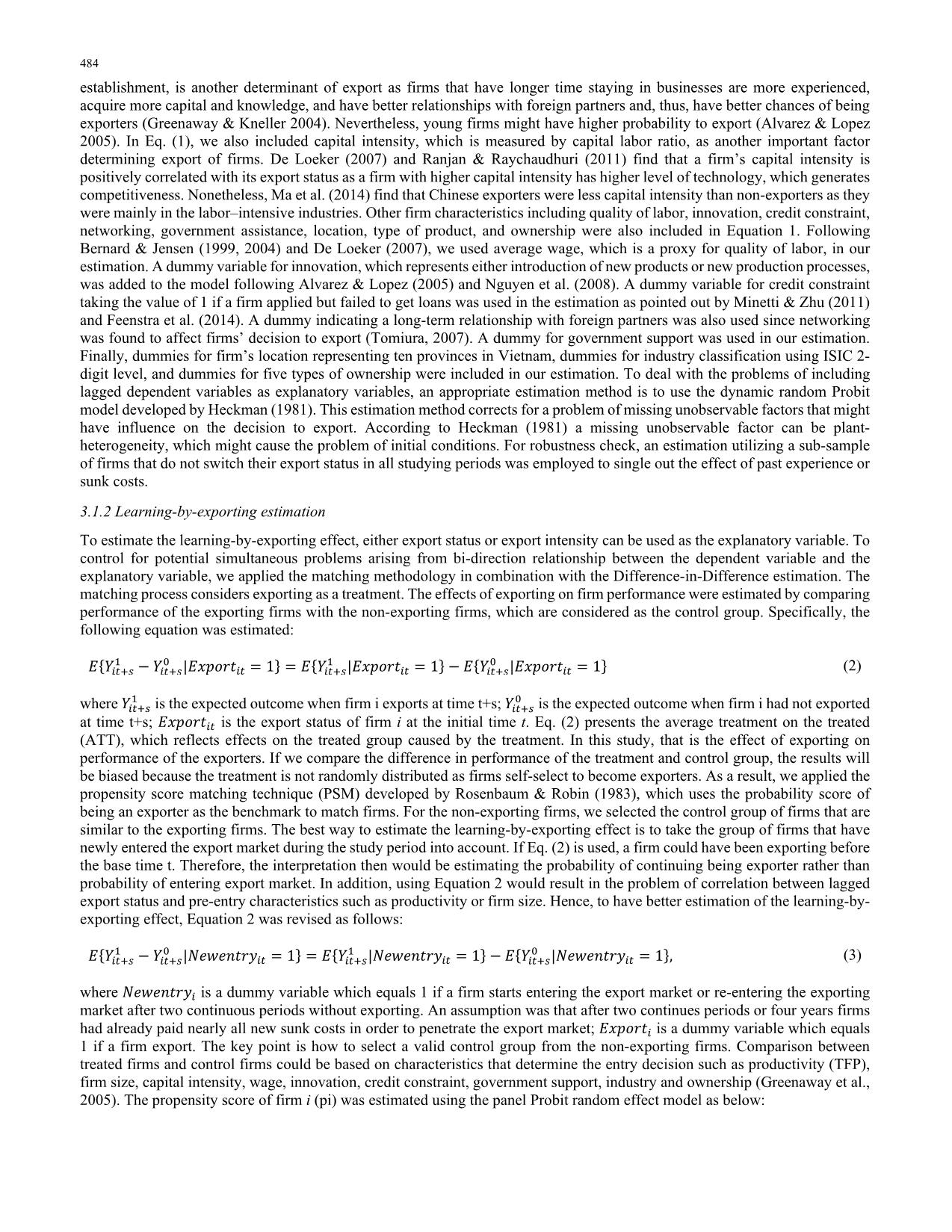
Trang 4
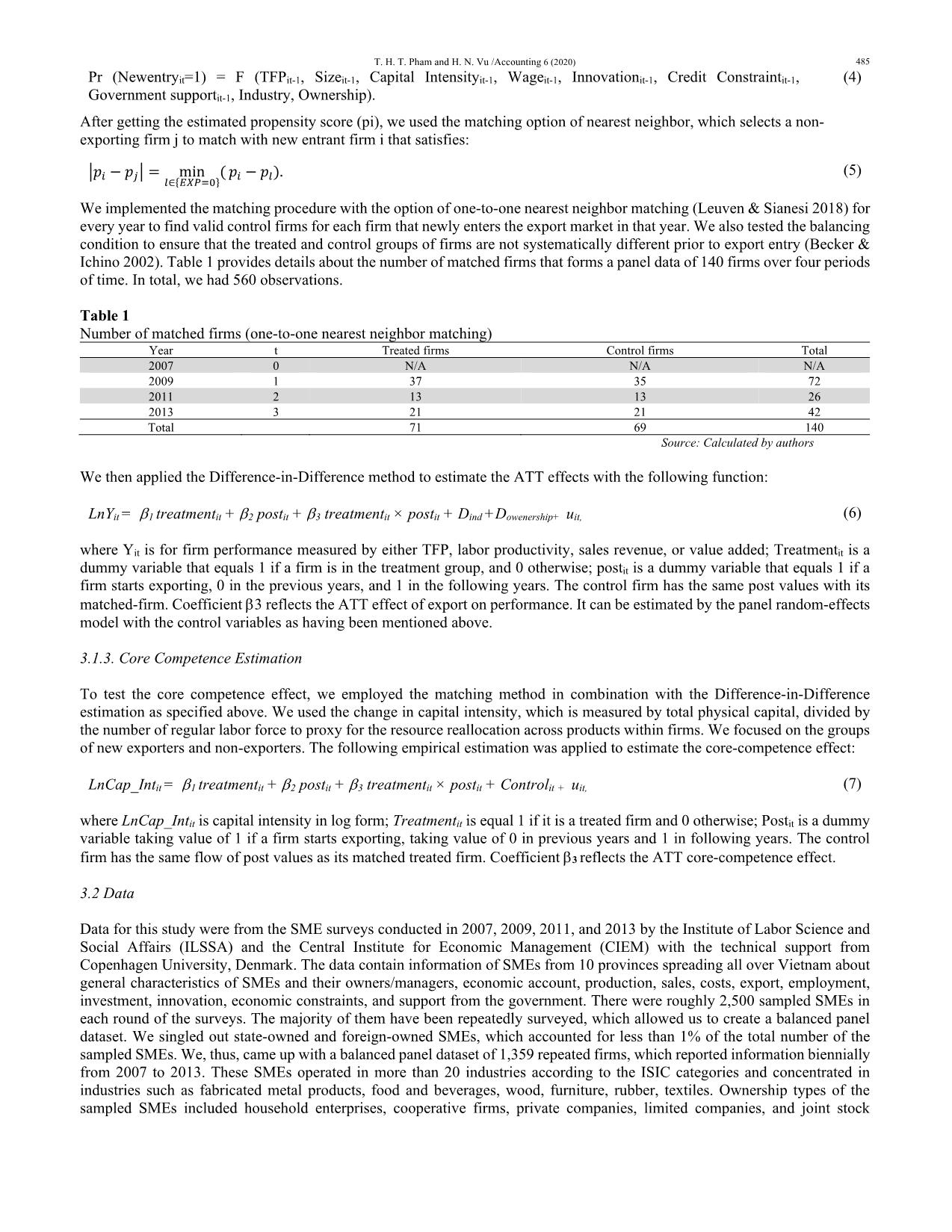
Trang 5
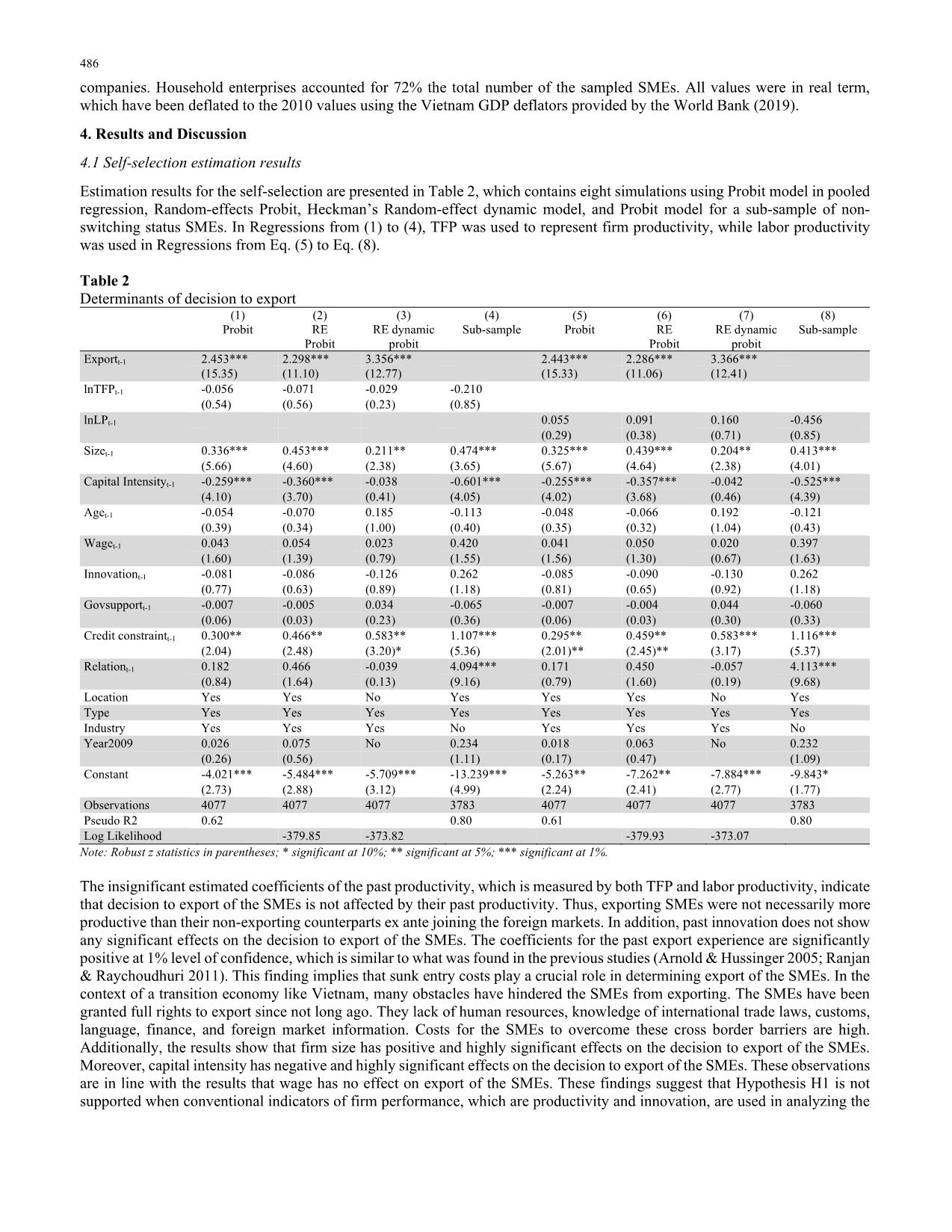
Trang 6
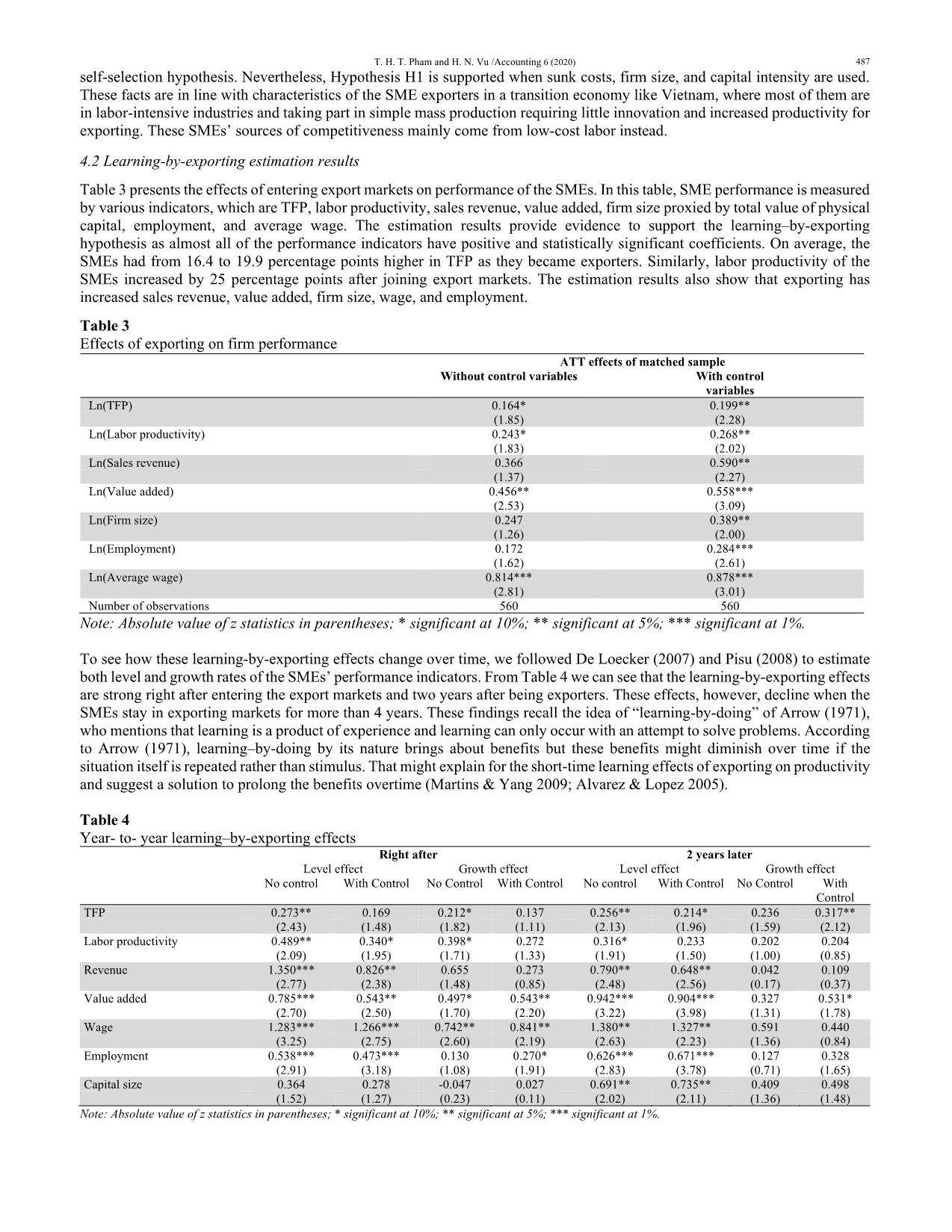
Trang 7
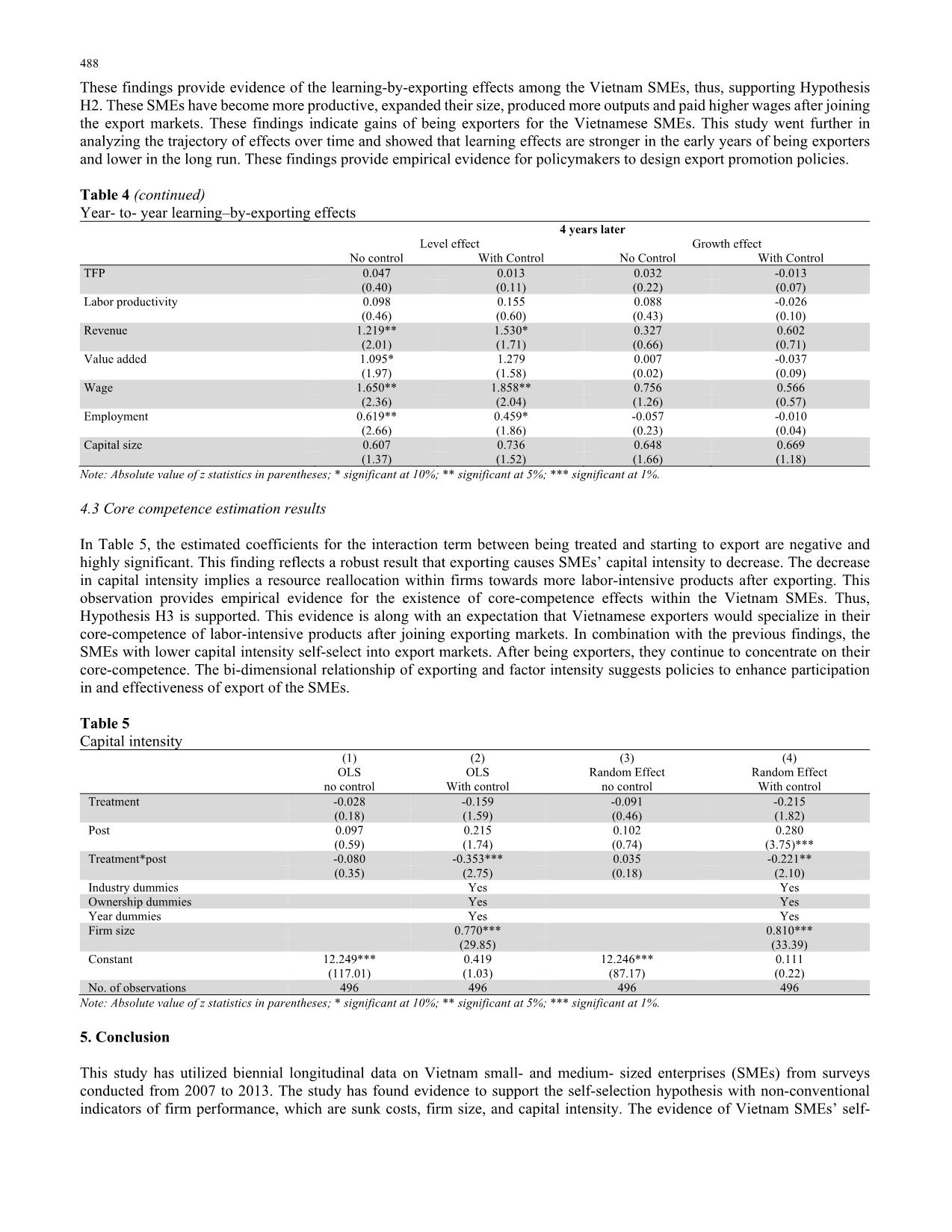
Trang 8
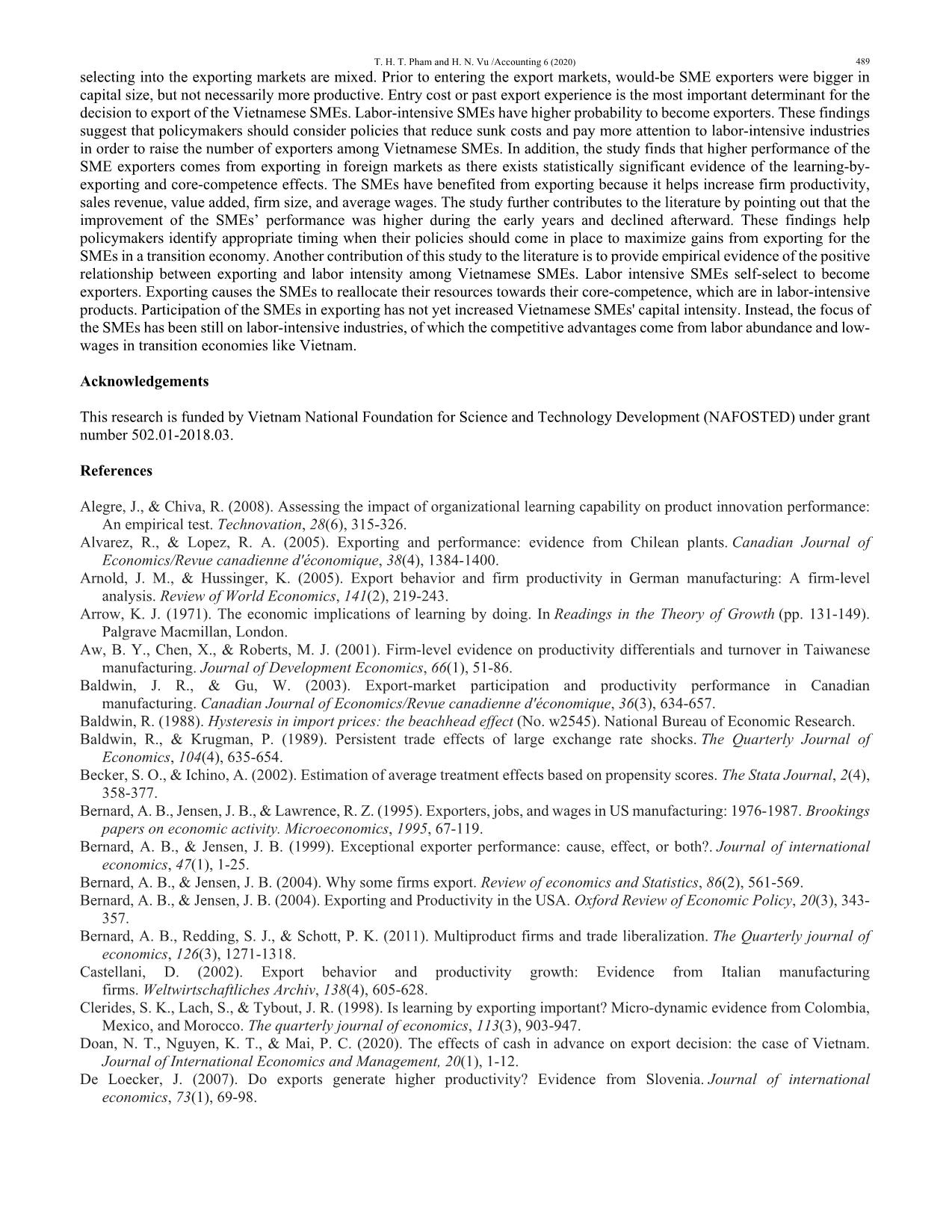
Trang 9
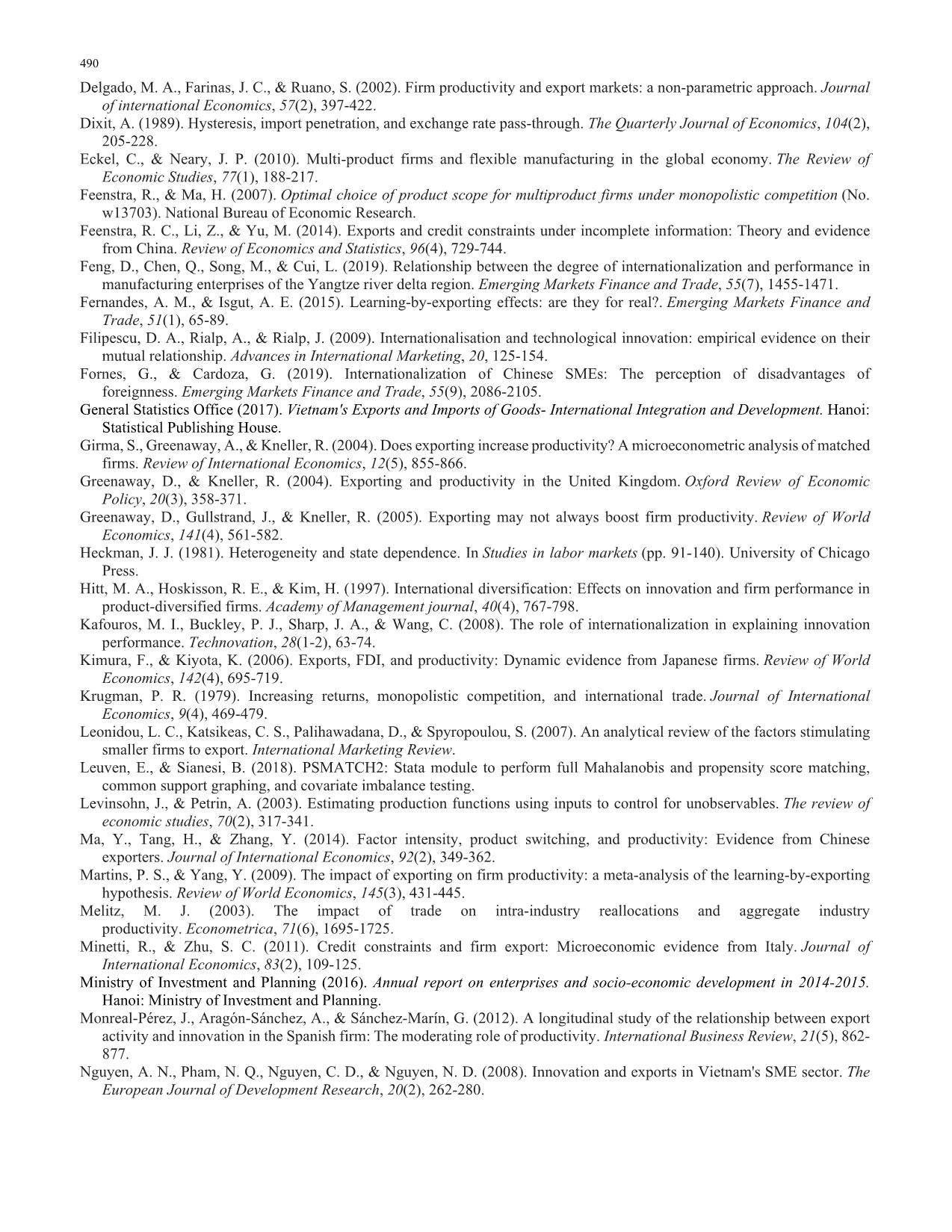
Trang 10
Tải về để xem bản đầy đủ
Tóm tắt nội dung tài liệu: A longitudinal study of self-selection, learning-by-exporting and core-competence: The case of smalland medium-sized enterprises in Vietnam
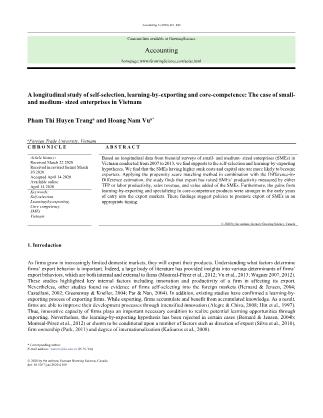
resources towards their core-competence, which are in labor-intensive
products. Participation of the SMEs in exporting has not yet increased Vietnamese SMEs' capital intensity. Instead, the focus of
the SMEs has been still on labor-intensive industries, of which the competitive advantages come from labor abundance and low-
wages in transition economies like Vietnam.
Acknowledgements
This research is funded by Vietnam National Foundation for Science and Technology Development (NAFOSTED) under grant
number 502.01-2018.03.
References
Alegre, J., & Chiva, R. (2008). Assessing the impact of organizational learning capability on product innovation performance:
An empirical test. Technovation, 28(6), 315-326.
Alvarez, R., & Lopez, R. A. (2005). Exporting and performance: evidence from Chilean plants. Canadian Journal of
Economics/Revue canadienne d'économique, 38(4), 1384-1400.
Arnold, J. M., & Hussinger, K. (2005). Export behavior and firm productivity in German manufacturing: A firm-level
analysis. Review of World Economics, 141(2), 219-243.
Arrow, K. J. (1971). The economic implications of learning by doing. In Readings in the Theory of Growth (pp. 131-149).
Palgrave Macmillan, London.
Aw, B. Y., Chen, X., & Roberts, M. J. (2001). Firm-level evidence on productivity differentials and turnover in Taiwanese
manufacturing. Journal of Development Economics, 66(1), 51-86.
Baldwin, J. R., & Gu, W. (2003). Export‐market participation and productivity performance in Canadian
manufacturing. Canadian Journal of Economics/Revue canadienne d'économique, 36(3), 634-657.
Baldwin, R. (1988). Hysteresis in import prices: the beachhead effect (No. w2545). National Bureau of Economic Research.
Baldwin, R., & Krugman, P. (1989). Persistent trade effects of large exchange rate shocks. The Quarterly Journal of
Economics, 104(4), 635-654.
Becker, S. O., & Ichino, A. (2002). Estimation of average treatment effects based on propensity scores. The Stata Journal, 2(4),
358-377.
Bernard, A. B., Jensen, J. B., & Lawrence, R. Z. (1995). Exporters, jobs, and wages in US manufacturing: 1976-1987. Brookings
papers on economic activity. Microeconomics, 1995, 67-119.
Bernard, A. B., & Jensen, J. B. (1999). Exceptional exporter performance: cause, effect, or both?. Journal of international
economics, 47(1), 1-25.
Bernard, A. B., & Jensen, J. B. (2004). Why some firms export. Review of economics and Statistics, 86(2), 561-569.
Bernard, A. B., & Jensen, J. B. (2004). Exporting and Productivity in the USA. Oxford Review of Economic Policy, 20(3), 343-
357.
Bernard, A. B., Redding, S. J., & Schott, P. K. (2011). Multiproduct firms and trade liberalization. The Quarterly journal of
economics, 126(3), 1271-1318.
Castellani, D. (2002). Export behavior and productivity growth: Evidence from Italian manufacturing
firms. Weltwirtschaftliches Archiv, 138(4), 605-628.
Clerides, S. K., Lach, S., & Tybout, J. R. (1998). Is learning by exporting important? Micro-dynamic evidence from Colombia,
Mexico, and Morocco. The quarterly journal of economics, 113(3), 903-947.
Doan, N. T., Nguyen, K. T., & Mai, P. C. (2020). The effects of cash in advance on export decision: the case of Vietnam.
Journal of International Economics and Management, 20(1), 1-12.
De Loecker, J. (2007). Do exports generate higher productivity? Evidence from Slovenia. Journal of international
economics, 73(1), 69-98.
490
Delgado, M. A., Farinas, J. C., & Ruano, S. (2002). Firm productivity and export markets: a non-parametric approach. Journal
of international Economics, 57(2), 397-422.
Dixit, A. (1989). Hysteresis, import penetration, and exchange rate pass-through. The Quarterly Journal of Economics, 104(2),
205-228.
Eckel, C., & Neary, J. P. (2010). Multi-product firms and flexible manufacturing in the global economy. The Review of
Economic Studies, 77(1), 188-217.
Feenstra, R., & Ma, H. (2007). Optimal choice of product scope for multiproduct firms under monopolistic competition (No.
w13703). National Bureau of Economic Research.
Feenstra, R. C., Li, Z., & Yu, M. (2014). Exports and credit constraints under incomplete information: Theory and evidence
from China. Review of Economics and Statistics, 96(4), 729-744.
Feng, D., Chen, Q., Song, M., & Cui, L. (2019). Relationship between the degree of internationalization and performance in
manufacturing enterprises of the Yangtze river delta region. Emerging Markets Finance and Trade, 55(7), 1455-1471.
Fernandes, A. M., & Isgut, A. E. (2015). Learning-by-exporting effects: are they for real?. Emerging Markets Finance and
Trade, 51(1), 65-89.
Filipescu, D. A., Rialp, A., & Rialp, J. (2009). Internationalisation and technological innovation: empirical evidence on their
mutual relationship. Advances in International Marketing, 20, 125-154.
Fornes, G., & Cardoza, G. (2019). Internationalization of Chinese SMEs: The perception of disadvantages of
foreignness. Emerging Markets Finance and Trade, 55(9), 2086-2105.
General Statistics Office (2017). Vietnam's Exports and Imports of Goods- International Integration and Development. Hanoi:
Statistical Publishing House.
Girma, S., Greenaway, A., & Kneller, R. (2004). Does exporting increase productivity? A microeconometric analysis of matched
firms. Review of International Economics, 12(5), 855-866.
Greenaway, D., & Kneller, R. (2004). Exporting and productivity in the United Kingdom. Oxford Review of Economic
Policy, 20(3), 358-371.
Greenaway, D., Gullstrand, J., & Kneller, R. (2005). Exporting may not always boost firm productivity. Review of World
Economics, 141(4), 561-582.
Heckman, J. J. (1981). Heterogeneity and state dependence. In Studies in labor markets (pp. 91-140). University of Chicago
Press.
Hitt, M. A., Hoskisson, R. E., & Kim, H. (1997). International diversification: Effects on innovation and firm performance in
product-diversified firms. Academy of Management journal, 40(4), 767-798.
Kafouros, M. I., Buckley, P. J., Sharp, J. A., & Wang, C. (2008). The role of internationalization in explaining innovation
performance. Technovation, 28(1-2), 63-74.
Kimura, F., & Kiyota, K. (2006). Exports, FDI, and productivity: Dynamic evidence from Japanese firms. Review of World
Economics, 142(4), 695-719.
Krugman, P. R. (1979). Increasing returns, monopolistic competition, and international trade. Journal of International
Economics, 9(4), 469-479.
Leonidou, L. C., Katsikeas, C. S., Palihawadana, D., & Spyropoulou, S. (2007). An analytical review of the factors stimulating
smaller firms to export. International Marketing Review.
Leuven, E., & Sianesi, B. (2018). PSMATCH2: Stata module to perform full Mahalanobis and propensity score matching,
common support graphing, and covariate imbalance testing.
Levinsohn, J., & Petrin, A. (2003). Estimating production functions using inputs to control for unobservables. The review of
economic studies, 70(2), 317-341.
Ma, Y., Tang, H., & Zhang, Y. (2014). Factor intensity, product switching, and productivity: Evidence from Chinese
exporters. Journal of International Economics, 92(2), 349-362.
Martins, P. S., & Yang, Y. (2009). The impact of exporting on firm productivity: a meta-analysis of the learning-by-exporting
hypothesis. Review of World Economics, 145(3), 431-445.
Melitz, M. J. (2003). The impact of trade on intra‐industry reallocations and aggregate industry
productivity. Econometrica, 71(6), 1695-1725.
Minetti, R., & Zhu, S. C. (2011). Credit constraints and firm export: Microeconomic evidence from Italy. Journal of
International Economics, 83(2), 109-125.
Ministry of Investment and Planning (2016). Annual report on enterprises and socio-economic development in 2014-2015.
Hanoi: Ministry of Investment and Planning.
Monreal-Pérez, J., Aragón-Sánchez, A., & Sánchez-Marín, G. (2012). A longitudinal study of the relationship between export
activity and innovation in the Spanish firm: The moderating role of productivity. International Business Review, 21(5), 862-
877.
Nguyen, A. N., Pham, N. Q., Nguyen, C. D., & Nguyen, N. D. (2008). Innovation and exports in Vietnam's SME sector. The
European Journal of Development Research, 20(2), 262-280.
T. H. T. Pham and H. N. Vu /Accounting 6 (2020) 491
Pär, H., & Nan, L. N. (2004). Exports as an Indicator on or Promoter of Successful Swedish Manufacturing Firms in the
1990s. Review of World Economics, 140(3), 415-445.
Park, A., Yang, D., Shi, X., & Jiang, Y. (2010). Exporting and firm performance: Chinese exporters and the Asian financial
crisis. The Review of Economics and Statistics, 92(4), 822-842.
Park, B. I. (2011). Knowledge transfer capacity of multinational enterprises and technology acquisition in international joint
ventures. International Business Review, 20(1), 75-87.
Pisu, M. (2008). Export destinations and learning-by-exporting: Evidence from Belgium. National Bank of Belgium working
paper, (140).
Pla-Barber, J., & Alegre, J. (2007). Analysing the link between export intensity, innovation and firm size in a science-based
industry. International Business Review, 16(3), 275-293.
Ranjan, P., & Raychaudhuri, J. (2011). Self‐selection vs learning: evidence from Indian exporting firms. Indian Growth and
Development Review, 4(1), 22-37.
Roberts, M. J., & Tybout, J. R. (1997). The decision to export in Colombia: An empirical model of entry with sunk costs. The
American Economic Review, 545-564.
Rosenbaum, P. R., & Rubin, D. B. (1983). The central role of the propensity score in observational studies for causal
effects. Biometrika, 70(1), 41-55.
Silva, A., Afonso, Ó., & Africano, A. P. (2010). Do Portuguese manufacturing firms learn by exporting? (No. 373).
Universidade do Porto, Faculdade de Economia do Porto.
Tomiura, E. (2007). Foreign outsourcing, exporting, and FDI: A productivity comparison at the firm level. Journal of
International Economics, 72(1), 113-127.
VCCI. 2017. Annual Report on Vietnamese Business 2016. Hanoi: Information and Communications Publishing House.
Vu, H., Lim, S., Holmes, M., & Doan, T. (2013). Firm Exporting and Employee Benefits: First Evidence from Vietnam
Manufacturing SMEs. Economics Bulletin, 33(1), 519-535.
Vu, H. N., & Hoang, B. T. (2020). Business environment and innovation persistence: the case of small-and medium-sized
enterprises in Vietnam. Economics of Innovation and New Technology, https://doi.org/10.1080/10438599.2019.1689597
Wagner, J. (2007). Exports and productivity: A survey of the evidence from firm‐level data. World Economy, 30(1), 60-82.
Wagner, J. (2012). International trade and firm performance: a survey of empirical studies since 2006. Review of World
Economics, 148(2), 235-267.
Wernerfelt, B. (1984). A resource‐based view of the firm. Strategic Management Journal, 5(2), 171-180.
World Bank (2019). The Wold Bank. Retrieved 06 01, 2017, from data.worldbank.org:
https://data.worldbank.org/indicator/NY.GDP.DEFL.ZS?locations=VN
Appendix A
Bernard and Jensen (1995, 1999, 2004) started with a simple case with one time period and no entry cost, the profit function it
of firm i at time period t is as below:
it (Xt, Zit) = pt . qit* - cit (Xt, Zit| qit*) Eq. (A.1)
where qit* is the optimal quantity produced if a firm exports; cit is the cost of producing quantity qit*; pt is the selling price of goods
in the foreign market; Xt is the vector of exogenous factors that affect production of the firm such as exchange rate, export promotion
regimes; Zit is a vector of all endogenous or firm-specific factors that have influence on profitability such as productivity, size, age,
labor quality, innovation. If an expected profit of exporting is equal to or greater than zero, a firm will export. Otherwise, it
remains serving the domestic market only. Denoting Yit as firm i’s export status at time t, then Yit =1 if it 0 and Yit =0 if
it<0. In the multiple periods case, let represent a single discounting rate, then expected profit of a firm becomes:
it (Xt, Zit) = Et ( )
Eq. (A.2)
As long as the cost function of today production does not depend on production in previous periods, then the expected profit
function in the multi-period case is similar to the single period case. Otherwise, the current export status will have effects on
future export status and the value function of the optimizing problem is as follow:
( it. Yit + . Et [Vit+1(.)|q*it] ) Eq. (A.3)
A firm will export in period t if the following inequality satisfies:
it + . Et[Vit+1 (.) | q*it>0] > . Et[Vit+1 (.) | q*it=0] Eq. (A.4)
s t.[ ps.q*is cis.(Xs, Zis | qis*)]
s t
Vit (.) max{q*it }
492
Entry costs are denoted by N. It is normal to make an assumption that firm will not have to pay entry costs if they had already
exported (i.e. N=0 if Yit-1=1). When making a decision to export, firms understand that if they export today, they might not
have to pay entry costs in the future. In a single-period case with entry costs, a firm’s profit is specified as follows:
Π௧ᇱ (Xt, Zit, q*it-1) = pt . qit* - cit (Xt, Zit, q*it-1| qit*) – N (1-Yit-1) Eq. (A.5)
This means firms do not have to pay entry cost if they exported in the previous periods, i.e. Yit-1=1. Firms will export if expected
profits minus entry costs are positive. It means Yit=1 if Π௧ᇱ >0. In a multi-period case with entry costs, firms choose a sequence
of output levels, , that maximizes current and discounted future profit. It means it = Et ( s-t [Π௦ᇱ .Yis]), where in
the single-period Π௦ᇱ is non-negative as firms have an option of not exporting. With a value function as represented below:
(Π௧ᇱ . [q*it >0]+ . Et [Vit+1(.)|q*it]) Eq. (A.6)
Firm i will export in time t if expected profit net any entry costs is greater than zero as follows:
pt . qit*+ . (Et[Vit+1 (.) | q*it>0] - Et[Vit+1 (.) | q*it=0]) - cit (Xt, Zit, q*it-1| qit*) – N (1-Yit-1) >0 Eq. (A.7)
Or
pt . qit*+ . (Et[Vit+1 (.) | q*it>0] - Et[Vit+1 (.) | q*it=0]) > cit (Xt, Zit, q*it-1| qit*) + N (1-Yit-1) Eq. (A.8)
If we define Π௧∗ = pt . qit*+ . (Et[Vit+1 (.) | q*it>0] - Et[Vit+1 (.) | q*it=0]), the decision to export by firm is given by the
following discrete choice equation:
𝑌௧ = ൜1 𝑖𝑓 Π௧∗ − 𝑐௧ − 𝑁(1 − 𝑌௧ିଵ) 00 𝑜𝑡ℎ𝑒𝑟𝑤𝑖𝑠𝑒 Eq. (A.9)
According to Roberts and Tybout (1997), a method of non-structural binary choice can be used to estimate the decision to export
with the following empirical model:
𝑌௧ = ቄ1 𝑖𝑓 𝛽𝑋௧ 𝛾𝑍௧ − 𝑁(1 − 𝑌௧ିଵ) 𝜀௧ 00 𝑜𝑡ℎ𝑒𝑟𝑤𝑖𝑠𝑒 Eq. (A.10)
© 2020 by the authors; licensee Growing Science, Canada. This is an open access article distributed
under the terms and conditions of the Creative Commons Attribution (CC-BY) license
(
{qit
*}s t
s t
Vit (.) max{q*it }
File đính kèm:
 a_longitudinal_study_of_self_selection_learning_by_exporting.pdf
a_longitudinal_study_of_self_selection_learning_by_exporting.pdf

